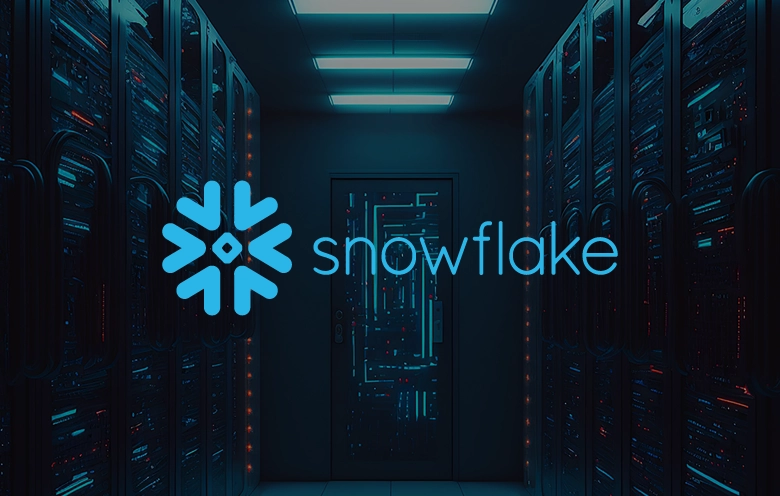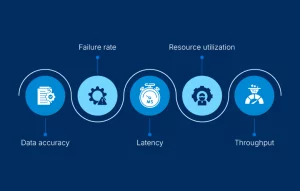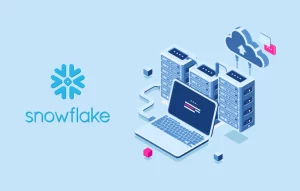In today’s data-intensive world, businesses of all sizes are facing increasing pressure to effectively manage and analyze their data. Big data and cloud-based solutions have grown in popularity. This has made traditional data warehousing solutions obsolete and inefficient.
Snowflake is a cloud-based data warehouse and analytics platform that has rapidly gained popularity in recent years. It is designed to meet the needs of data-driven applications in the current scenario.
Snowflake helps companies manage and analyze large quantities of data in a cost-effective and scalable way. This enables organizations to utilize their data more effectively.
Snowflake’s cloud-based approach offers numerous benefits over traditional data warehousing solutions, including increased scalability, security and cost-effectiveness.
This blog will give you an in-depth understanding of a cloud-based data platform. We will cover Snowflake’s features for data warehousing, its benefits and its use cases. This guide is useful for everyone – whether you’re new to Snowflake or an experienced user. It will provide valuable insights into the platform’s architecture, functionalities and best practices.
So, let’s dive in and discover how Snowflake consulting services can leverage the power of Snowflake to propel your business to new heights of data-driven excellence.
Almost all cloud data warehouses perform backups automatically,
resulting in 99.99% data availability and fault tolerance.
– Science Soft
What is Snowflake?
Snowflake is a cloud-based data platform that offers a comprehensive and scalable solution for storing, processing and analyzing data. It is designed to handle large volumes of structured and semi-structured data, providing organizations with the ability to derive valuable insights and make data-driven decisions. With its unique architecture and features, Snowflake enables businesses to leverage the power of data more efficiently and effectively.
Snowflake’s architecture uses a three-layer approach. It separates storage, computing and service resources. This allows Snowflake to handle large amounts of structured and semi-structured data. Also, with data warehousing, data integration, and data sharing features, Snowflake helps you manage and analyze large amounts of structured and semi-structured data effectively.
Managing and analyzing large amounts of data can be challenging. Traditional data warehousing solutions are often expensive, complicated and take up a lot of time. Snowflake offers a cloud-based data warehousing solution that eliminates many of the limitations and challenges of traditional solutions. Compared to traditional data warehousing solutions, Snowflake offers benefits such as scalability, flexibility and cost-effectiveness, making it an ideal choice for modern data management.
Additionally, Snowflake’s architecture enables seamless collaboration, easy integration with other tools, and efficient cloud-based data management, enhancing its value for business.
Snowflake’s cloud-based approach offers several benefits for business:
- Firstly, it eliminates the need for on-premise hardware and infrastructure, reducing costs and maintenance requirements.
- Additionally, Snowflake’s elastic computing allows for automatic scaling, ensuring that businesses only pay for the resources they need. Snowflake’s cloud-based approach enables faster data processing. It also allows for real-time analytics. This is because data can be accessed from any location, at any time.
- Finally, the cloud-based approach ensures that businesses can easily and securely share data with partners and customers.
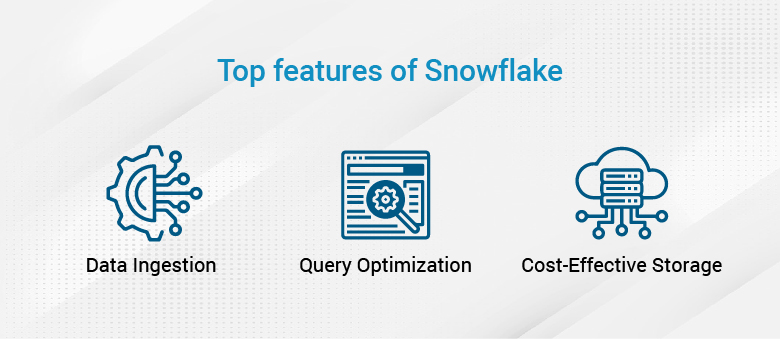
Snowflake’s three-layer architecture consists of a database storage layer, a query processing layer and a cloud services layer.
- The database storage layer stores data in a columnar format that allows for efficient compression and faster query processing.
- The query processing layer processes queries and provides query optimization and execution.
- Finally, the cloud services layer manages authentication, access control and other cloud-related services.
This architecture allows Snowflake to provide a scalable, flexible and high-performance cloud-based data warehousing solution.
The cloud data warehouse market size is anticipated to increase from USD 4.7 billion in 2021 to USD 12.9 billion by 2026.
-MarketsandMarkets Research
Snowflake vs. traditional data warehousing solutions
Snowflake’s approach to data warehousing is fundamentally different from traditional solutions. Unlike traditional data warehousing solutions, Snowflake’s cloud-based architecture provides scalability, agility and flexibility to organizations.
Snowflake has a unique approach to data storage. Organizations can use Snowflake to store and access data quickly and easily. There is no need to manage complex hardware or software infrastructure.
Snowflake’s three-layer architecture provides separation of database storage, query processing and cloud services layers. This enables Snowflake to scale storage and compute independently. It also helps to meet the demands of the workload. It allows you to only pay for what you need. This results in better performance, lower costs, and greater scalability, making Snowflake a popular choice for organizations of all sizes.
Snowflake’s cloud-based approach is advantageous. It enables users to easily integrate with other cloud-based services. This eliminates the need for complex and expensive on-premise infrastructure. With a highly secure and reliable platform, Snowflake offers a modern and flexible solution for businesses of all sizes.
Data warehousing, data integration and data sharing
As a leading cloud-based platform, Snowflake offers unparalleled scalability, flexibility and performance. It helps you seamlessly store, organize and analyze your data with its powerful data warehousing capabilities. You can integrate data from various sources effortlessly, leveraging Snowflake’s extensive data integration tools. It enables you to collaborate and share data securely across your organization and beyond.
Structured and semi-structured data
Snowflake enables easy management of various data formats. This includes structured data from relational databases and semi-structured data such as JSON and XML. Its advanced capabilities allow you to ingest, store and query structured and semi-structured data easily.
Snowflake’s approach does not require upfront data transformations. This makes it easy to explore and analyze various data types. It provides deeper insights to make data-driven decisions with its unparalleled support for structured and semi-structured data.
Business advantages of Snowflake
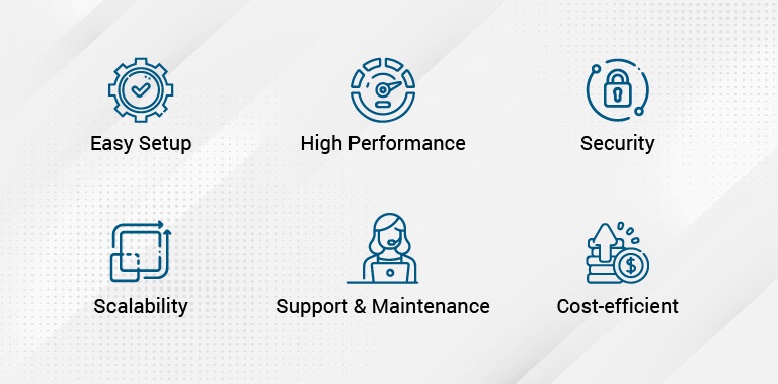
Snowflake’s cloud-native architecture ensures unmatched scalability and elasticity, allowing you to handle massive data workloads effortlessly. Its powerful data warehousing capabilities enable lightning-fast query performance, empowering your teams to derive insights in real-time. It helps in making data-driven decisions and drives growth.
Snowflake’s built-in data integration and sharing capabilities facilitate seamless collaboration and data exchange across teams and organizations. With its robust security measures and comprehensive governance controls, Snowflake ensures the privacy and integrity of your data. The agility, performance and security of Snowflake propels your business to new heights of success.
- Organizations across various industries have benefited from Snowflake’s capabilities, streamlining their data processes and improving efficiency.
For example, businesses have leveraged Snowflake to consolidate and centralize their data, resulting in faster and more accurate reporting and analysis. - Additionally, Snowflake’s scalability and cost-effectiveness make it an ideal choice for businesses of all sizes.
- Moreover, Snowflake’s pay-as-you-go model ensures cost optimization, allowing businesses to allocate their resources efficiently.
Snowflake’s security and compliance
Snowflake prioritizes the security and compliance needs of your business. It offers a robust set of built-in security features that protect sensitive data throughout its lifecycle. With end-to-end encryption, Snowflake ensures data remains secure both at rest and in transit. It implements granular access controls, enabling businesses to define fine-grained permissions and manage data access efficiently.
Moreover, Snowflake’s platform is built on a foundation of rigorous security practices, including regular security audits and vulnerability assessments. Snowflake holds several industry certifications, such as SOC 2 Type II, ISO 27001 and HIPAA. This shows their commitment to complying with strict regulatory requirements.
The benefits of Snowflake’s security and compliance measures are manifold for your business. You can confidently store and process sensitive data, mitigating the risk of breaches and data loss. By adhering to industry standards, Snowflake enables you to meet compliance obligations, avoiding legal and financial consequences.
Real-world use cases of Snowflake
1. Ohio Bureau of Workers’ Compensation (OBWC) addressed performance and scalability challenges by migrating to Snowflake’s cloud data platform. With native SQL capabilities, OBWC seamlessly transitioned, handling BI requests. Scalable architecture freed resources, while the data build tool (dbt) facilitated efficient data transformations. Snowflake’s data sharing and ML capabilities enhanced collaboration and advanced analytics.
2. Natwest, a leading UK bank, embraced environmental, social and governance (ESG) insights for compliance and supporting customers’ net-zero goals. They chose Snowflake as their SQL-based data platform, using dbt for efficient data profiling and quality management. With Snowflake’s capabilities, Natwest decommissioned legacy systems, reduced costs and strengthened data security.
3. EDF, an energy provider, chose Snowflake Data Cloud to transform ML model deployment and data processing. With elastic scalability and Snowpark’s versatility, EDF deploys ML models in AWS SageMaker using Python. Snowflake acts as a central repository, enabling end-to-end machine learning and valuable insights. This streamlines EDF’s operations, empowers data scientists and benefits customers with energy hub analytics.
Best practices for Snowflake
Unlock the full potential of your data with Snowflake by following these best practices:
- For data warehousing, design your schemas and tables with careful consideration of data types, compression and clustering keys to optimize query performance.
- When it comes to data integration, leverage Snowflake’s native connectors and third-party integration tools for seamless data ingestion from various sources.
- For data analytics, use Snowflake’s powerful SQL capabilities, including window functions and advanced analytics functions, to derive valuable insights.
- To optimize Snowflake’s performance and cost-effectiveness, monitor and tune your virtual warehouses and adjust their size and concurrency based on workload patterns.
- Additionally, take advantage of Snowflake’s auto-suspend and auto-resume features to minimize costs during idle periods.
By following these tips, you can maximize the value of Snowflake and drive success in your data-driven initiatives.
Adopt Snowflake now!
This guide has covered the key points to help you understand the power of Snowflake. We discussed the importance of data warehousing, data integration and data analytics. And also, how Snowflake can facilitate these processes. We explored best practices for optimizing performance and cost-effectiveness, as well as real-world examples of businesses benefiting from Snowflake.
Embrace Snowflake’s capabilities and unlock the full potential of data-driven decision-making. Try Snowflake today and experience the seamless scalability, flexibility and security it offers. Snowflake offers unparalleled performance that will empower your business.
This will give you the benefit of faster insights, improved operations and a competitive edge in today’s data-driven world. Embrace Snowflake’s secure and compliant data platform to safeguard your data assets and build trust with your customers.


